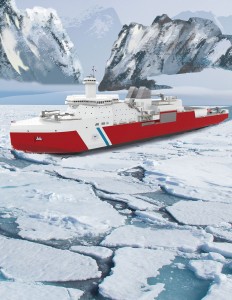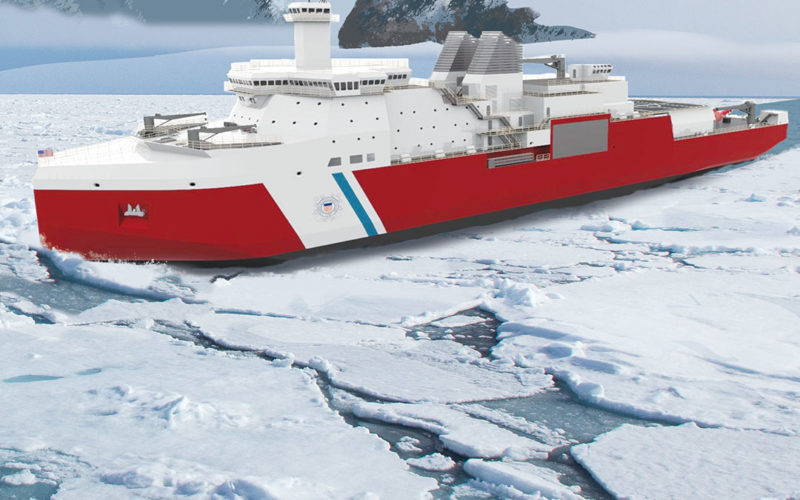
Construction on the U.S. Coast Guard’s first heavy icebreaker by Halter Marine has been delayed until 2022 due to design revisions and the coronavirus pandemic, the Coast Guard said.
Halter Marine originally planned to start production on the first polar security cutter (PSC) in early 2021, Halter officials said in 2019. The work is now expected to start sometime next year. The projected delivery date of May 2024 has not been changed.
“The Coast Guard is working with the shipbuilder to assess the impacts of covid-19 on (the) design and how that will affect the overall production and delivery of PSC,” Coast Guard Lt. Cmdr. Brittany Panetta said in an email.
The contract with Halter has not been modified, she added. Based on current projections, the lead ship’s operational schedule will not be impacted.
Congress provided full funding for the second PSC this fiscal year, and the Coast Guard’s fiscal 2022 proposed budget requests $170 million to procure materials for the third.
“The new PSCs will enable the U.S. Coast Guard to exercise leadership through effective presence; enforce treaties and other laws needed to safeguard both industry and the environment; and provide logistical support — including vessel escort — to facilitate the movement of goods and personnel necessary to support scientific research, commerce, national security activities and maritime safety,” Panetta said.
Halter did not respond to a request for comment.
Meanwhile, Canada announced in May it will construct two polar icebreakers with capabilities beyond its current heavy icebreaker, CCGC Louis S. St-Laurent, which was commissioned in 1969 and will retire when the first new ship is delivered by 2030.
The larger icebreakers are equipped with bigger fuel tanks and will have a 30,000-nautical-mile range and 270 days of endurance, about 7,000 more miles and 65 more days than Louis S. St-Laurent.
More powerful and with a stronger hull, they can operate in most parts of the Arctic throughout the year.
“We will be able to have those polars anywhere in Canada’s Arctic waters 12 months a year, which is a huge improvement for us,” said Chris Henderson, deputy commissioner of operations for the Canadian Coast Guard.
“A really big piece is going to be on the scientific front. We will be able to do science missions year-round,” Henderson added. “Those science missions are varied. They are going to be anything from oceanography issues — salinity, temperature, pressure depth, the nature of the water column, which is very important for understanding the nature of climate change — to the ability to support fish science and biological science as well.”
Last summer, researchers measured the second-lowest extent of Arctic ice since satellite recording began in 1978, near the record in 2012. The 14 lowest ice years have occurred in the past 14 years, according to the National Snow and Ice Data Center in Colorado.
As ice diminishes in the polar regions, human activity is increasing there. Arctic nations are preparing for more shipping activity, fossil fuel and mineral exploration, tourism, and naval activity as competition among nations for resources increases.
Amid this pressure, scientific research missions in the Arctic and Antarctic are trying to assess rapid climate change and its consequences for global weather patterns, large fisheries and vulnerable indigenous populations, among other impacts.
Even with climate change, there will still be plenty of ice in the Arctic, increasing demand for heavy, long-range icebreakers capable of working year-round in high-latitude environments.
To meet the demand, the U.S. Coast Guard is upgrading its capability with three new heavy icebreakers and three medium ones. The Canadian Coast Guard is slated to receive 30 new ships under Canada’s National Shipbuilding Strategy (NSS) to modernize its aging fleet and the Royal Canadian Navy fleet.
The two new polar icebreakers for Canada are in addition to six new medium icebreakers announced in 2019. Other ships included in the NSS are three offshore fisheries science vessels already delivered to the fleet; an oceanographic science vessel under construction; two Arctic offshore patrol ships; and 16 multi-purpose vessels.
The NSS also aims to revitalize Canada’s shipbuilding industry by adding predictability to federal vessel procurement to avoid boom-and-bust cycles that have affected shipbuilding in the past.
One of the polar icebreakers will be built by Seaspan Shipyards in Vancouver, British Columbia. The second will be built by Davie Shipbuilding in Levis, Quebec, pending Davie’s completion of the selection process to be the nation’s third strategic partner for large ships under the NSS, the government said in May. Irving Shipbuilding in Halifax, Nova Scotia, is the other strategic partner.
“That third shipyard,” Henderson said, “allows us to increase the output and shorten the timeline to recapitalize the fleet.”

